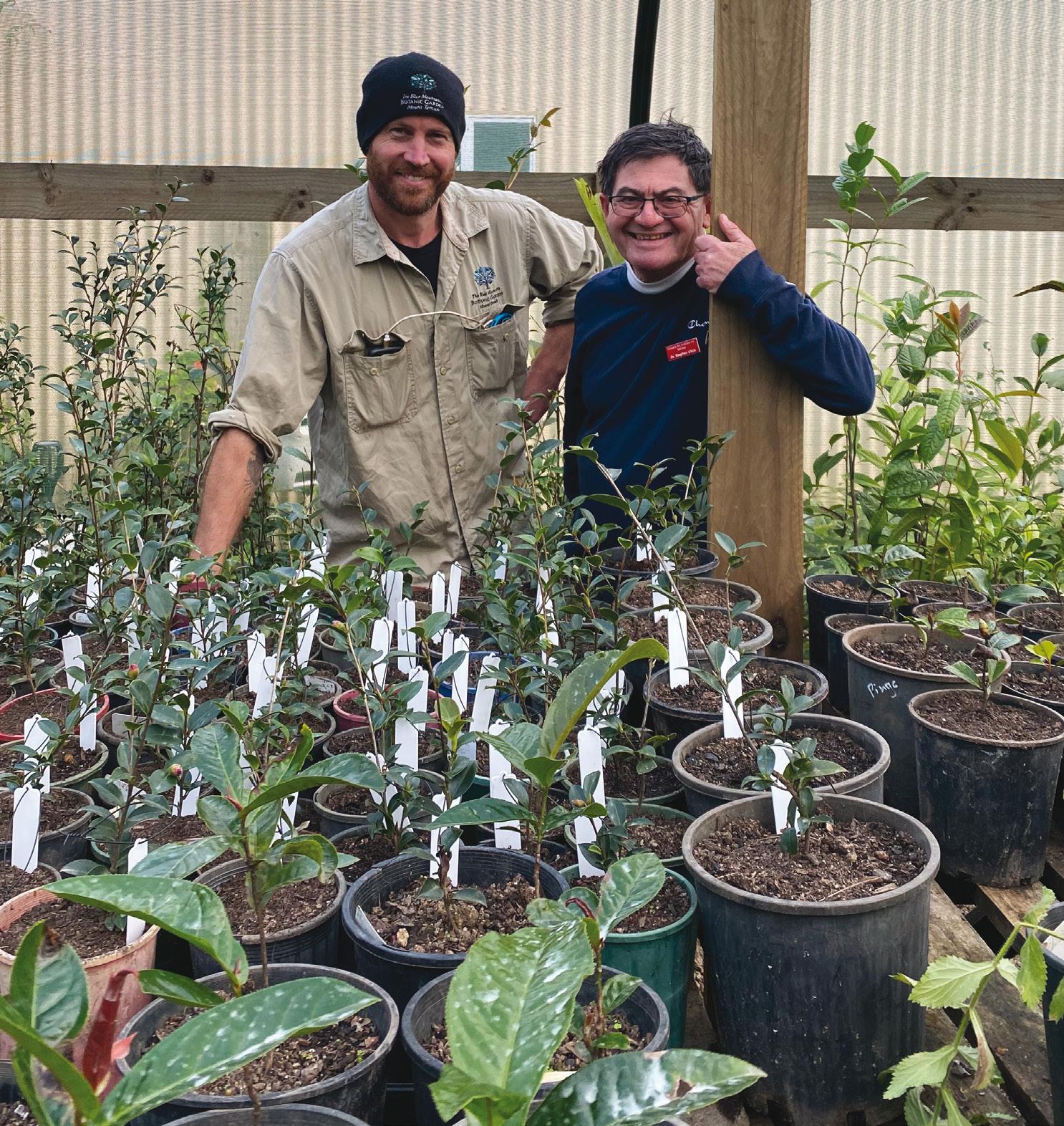
9 minute read
Treasure hunt The quest to preserve Australia’s rare camellias
HUNTING FOR EXOTIC TREASURE
WITH AUSTRALIA'S TROVE OF RARE CAMELLIAS UNDER THREAT, EFFORTS ARE UNDERWAY TO CREATE A HAVEN ON THE SLOPES OF MOUNT TOMAH. MARION WHITEWHEAD REPORTS.
Advertisement
In 1999 George Orel and Tony Curry, on a visit to Vietnam, saw an unusual white form of the beautiful Camellia amplexicaulis in a nursery in Hanoi. Having never seen this particular plant before, they offered to purchase cuttings but were denied. Upon returning to the nursery in 2001, they found the same plant as George Orel described it, “on its last legs”, and after some haggling, managed to purchase its last two living branches.
Once back in Australia the pair had success grafting the branches, which they subsequently found were from a new camellia species, Camellia lucii, now extinct in the wild. In the last year, as part the Gardens’ efforts to build one of the best camellia collections in the country, we have been lucky enough to welcome a specimen of Camellia lucii into our collection at the Blue Mountains Botanic Garden.
With increasingly strict quarantine laws in Australia, the importation of plant material into the country is becoming more and more difficult. These restrictions better protect our pristine bushland and established garden plants from viruses, diseases and fungal infections, but they also dramatically limit the diversity of exotic plants in Australia. Consequently, stories like the discovery of Camellia lucii, will become fewer and farther between. Not surprisingly, attention has now turned to collecting and preserving rare and dwindling collections of plants in Australia, for fear that if we lose these specimens, we may never see them again.
With this goal in mind, over the past three years Senior Horticulturist Mitch Carle and I have been working to locate, collect and propagate, rare camellias at the Blue Mountains Botanic Garden.
There are a variety of factors that have played into camellia cultivars and species becoming rare or disappearing from Australia’s backyards and collections. Firstly, garden faddism means that plants come into, and fall out of favour, according to gardening and aesthetic trends (colours, flower size, density of foliage, etc.). As the popularity of different features dip, so too does the production and subsequent ownership
of cultivars (variants selected and cultivated by humans). When it comes to straight Camellia species (native plants that occur naturally), the story is slightly different, with a lot of species never taking off as garden plants and instead becoming collectors’ items. The problem is that collectors age or move on from the properties in which they’ve built their collections, and with few members of the next generation taking up the mantle of camellia collecting, plant numbers are dwindling. In some cases, there are only one or two plants of some species and cultivars left in the entire country.
Our living collection strategy defines a series of themes that the collections we curate must fall into – from holding importance in terms of research, conservation and education, to historical significance and value in ornamental displays. Camellias meet every one of these criteria. Beyond being a plant that even the most novice garden enthusiast will recognise, camellias have been desirable ethnobotanically for centuries, with tea coming from Camellia sinensis. Horticulturally, they are easy to grow and flower, and suffer relatively few diseases and blights. Quite a few of our camellias and the species we are working
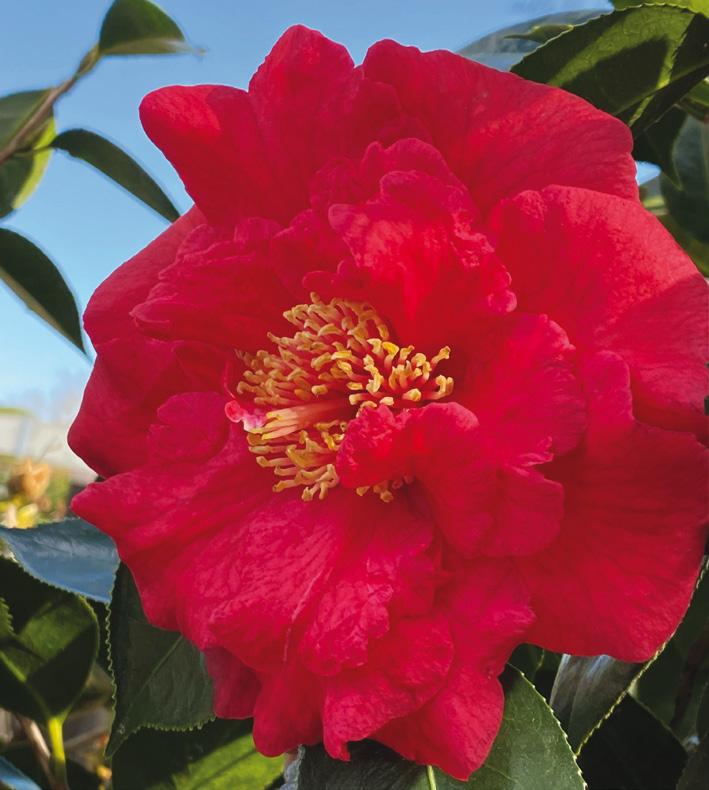
Senior horticulturalist Mitch Carle and Camellia Ark Australia's Stephen Utick

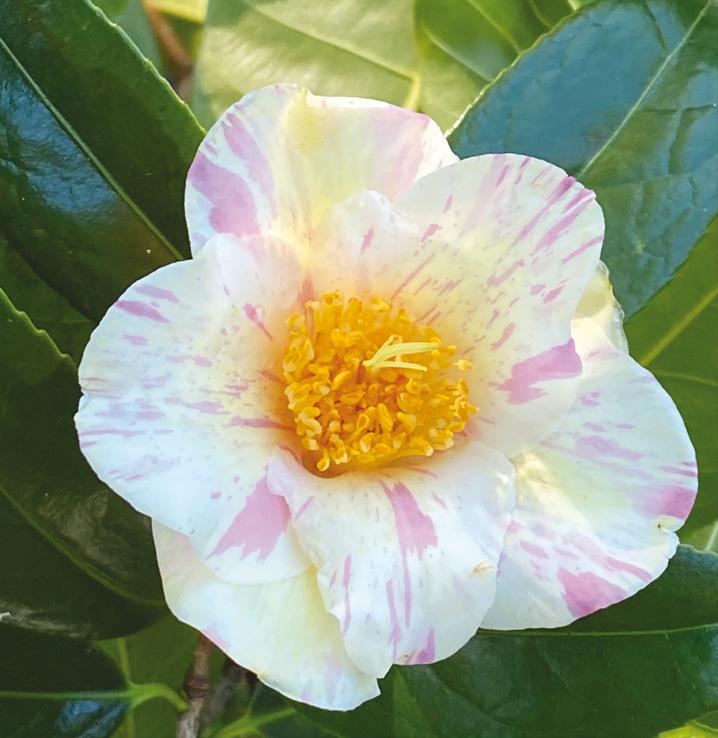

Photos: © Royal Botanic Gardens and Domain Trust
Supervisor of Ornamental Gardens and Nursery Marion Whitehead cataloguing the Gardens' collection Camellia reticulata ‘Teresa Park’
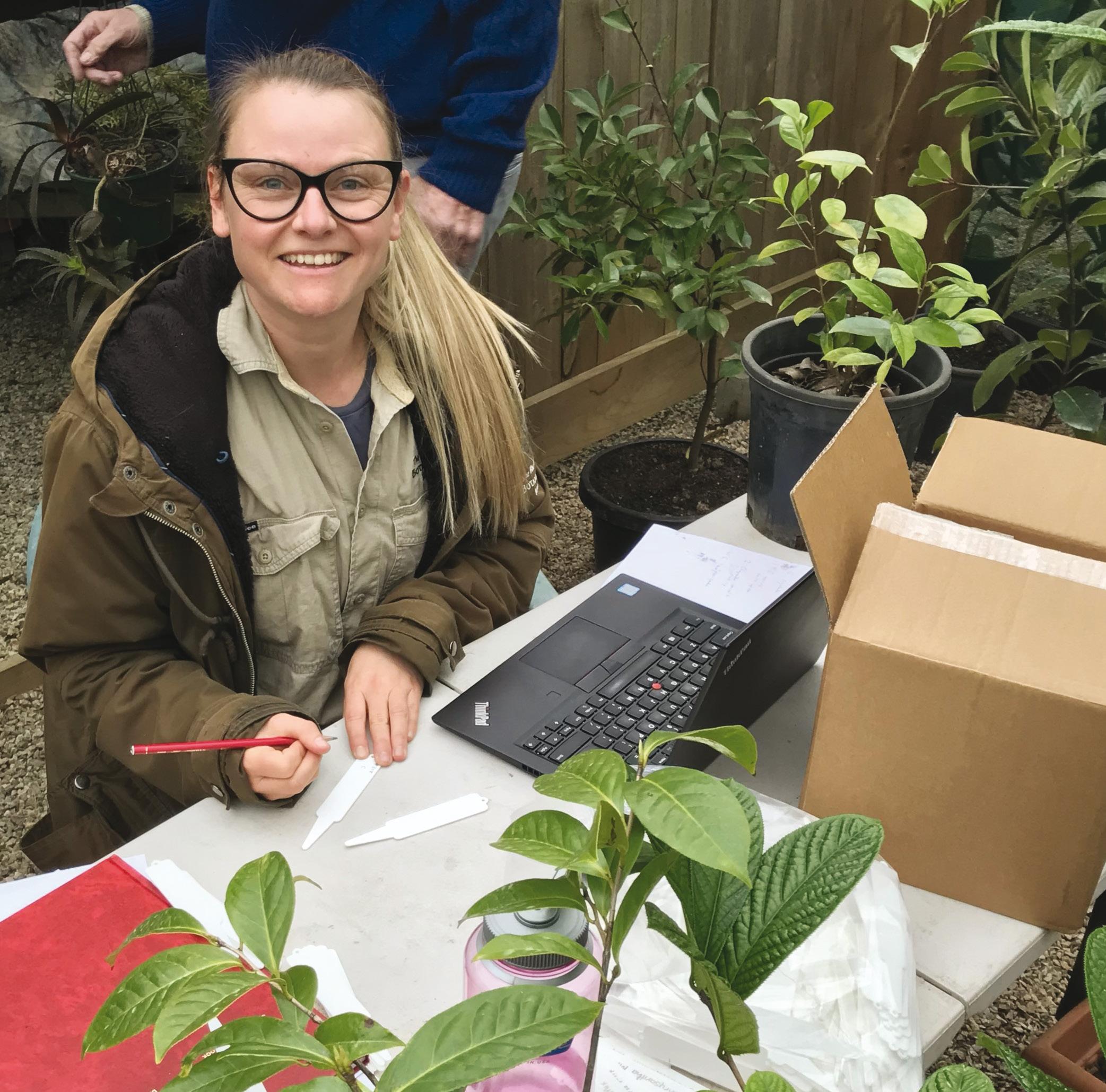
Camellia amplexicaulus pendulous form
Camellia japonica hybrid 'Kogane Nishiki'
Unidentified yellow camellia
Camellia nitidissima Camellia japonica ‘Yours Truley’ with mutation
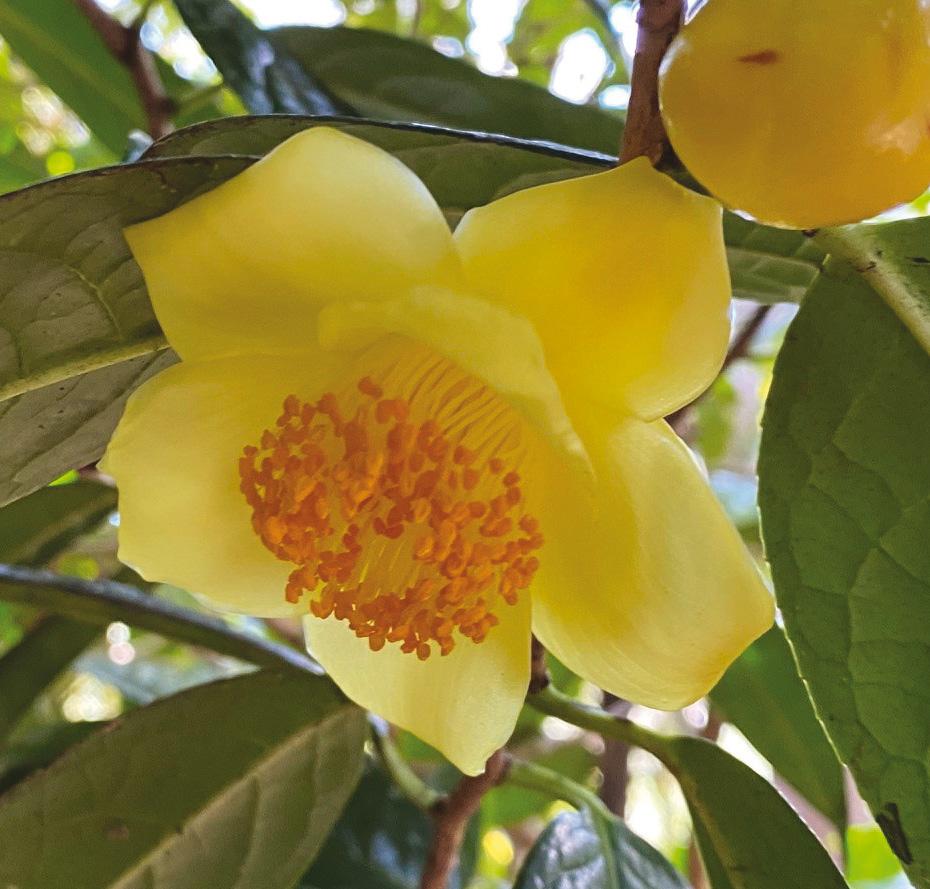

Camellia japonica ’Patricia Ann’

to collect are listed on the International Union for Conservation of Nature (IUCN) Red List as vulnerable, endangered, near threatened, extinct in the wild and critically endangered. And as an organisation, we are approaching 200 years of safeguarding, showcasing, and tending to camellias, with the first camellia planted in Australia at the Royal Botanic Garden Sydney in 1823.
Before setting off to collect and protect these rarities, however, we need to know which ones are the most vulnerable and where to find them. To do this, we work in collaboration with Camellia Ark Australia (CAA), an organisation that strives to identify and preserve rare camellias. Through extensive networking and research, CAA locates camellia collections and gardens across the country that house these rare, horticultural treasures, and
identifies camellias at risk of being lost from our shores (and our gardens). We then identify what plants are the most critical to take into our living collection in terms of conservation, suitability to our different sites, and horticultural merit, and what would be the most beneficial to the visiting public.
In the case of many species of camellias in Australia, some plants exist in only a handful of collections and are some of the very last in the world, so safeguarding their existence is not just a horticultural issue but a matter of international conservation. Amassing a collection of these plants to be protected and displayed at the Botanic Gardens involves a large amount of research, travel, and a comprehensive propagation and distribution plan. And to assist in our search for rare Camellia species and cultivars, Carle and I have been lucky enough to be awarded the Clive and Lorna Backhouse Scholarship to fund our travel across New South Wales, and work with plant collectors to secure material from these precious plants. Over this past winter, on three separate trips that covered thousands of kilometres – and saw me consumer more McDonald’s hash browns than I’d like to admit – we visited numerous collectors who have curated mind-blowing backyard camellia collections. Each one of these collections took decades to put together – a testament to these individual’s unadulterated love of camellias.
In the Shoalhaven we encountered the most comprehensive collection of Camellia reticulatas I have ever seen. For decades, Stan and Lorraine Heath ran a successful camellia nursery, and every time specimens arrived to be sold, Lorraine cherry picked the very best to add to her collection. With perfectly shaped shrubs arranged in rows, the dinner plate-sized Camellia reticulata blooms could be admired up close, allowing us to inspect the ethereal beauty of the deep red “Teresa Park” and the delicate folds of the coral “Ruta Hagmann’s” swirl of petals.
Just down the road in Berry, Graeme Oke and Robyn Bryce’s Camellia Garden felt like it had been curated in the exact opposite way – a woodland that was a world unto itself, with hundreds of camellias left to grow to their natural size. Over a 42-year period, Oke and Bryce filled their four-acre garden with a forest
Camellia reticulata ‘Ruta Hagmann’
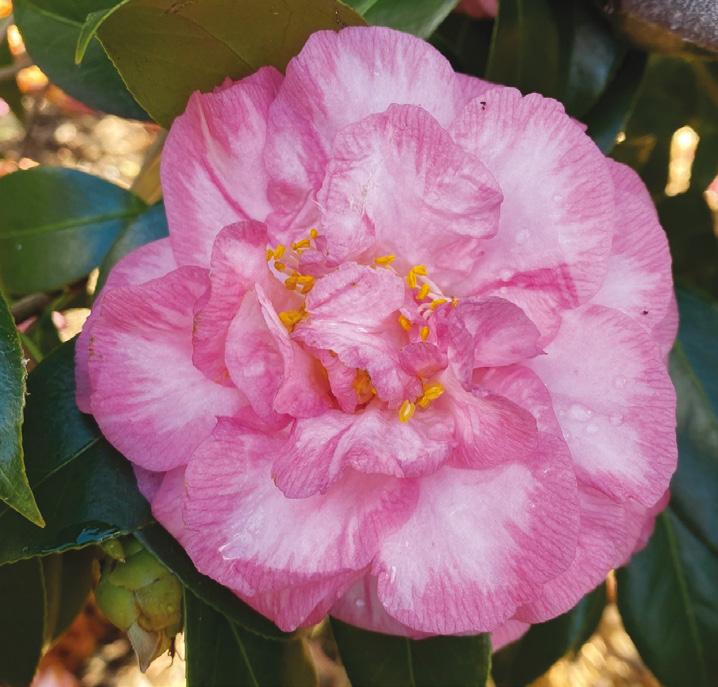
Camellia japonica ‘Spring Sonne’

Camellia japonica ‘Emmett Pfingstl’

of camellias, magnolias, acers and pieris. The towering overstorey had dropped a rainbow carpet of camellia petals and wandering through the property felt like some sort of dreamscape. While the flowers of Camellia reticulata couldn’t be closely inspected, the colourful canopy was unforgettable.
On two separate trips to Northern NSW, we basked in the glory of the Vietnamese and yellow-flowering camellias. With only Camellia nitidissima existing widely in cultivation, yellow certainly isn’t a colour you think of when you think of camellias. But with the deeply-veined, giant, glossy leaves, rainbow new foliage and fleshy flowers ranging from buttery yellow to pale gold with a purple edge, and some of the longest leaves I’ve ever seen on a camellia, this section of the genus is glorious. Within this group of camellias exist some of the rarest species in the world, with a few seen only once when they were originally collected and described, and then never seen again.
A highlight of these trips to Northern NSW was spending time with Glenn Calcott, a generous collector whose garden is a cornucopia of the weird, wonderful and rare. We spent three frenetic and delightful days with Calcott, dropping into nearby gardens that housed their own treasure trove of plants, and darting from rare camellias to towering African gardenias to Black Hoyas (which twine their way out into the sunlight from his expansive shade house), his dog Toby bouncing at our heels.
In our time travelling across the State to hunt down the most rare and exquisite camellias, we were exposed to the amazing variety in the genus and the multitude of ways in which they can be grown, all the while gleaning endless ideas for a new Camellia Garden at the Blue Mountains Botanic Garden. The best part of our hunt, however, was the warmth with which the camellia community welcomed us. Collectors took us into their homes, served us cups of tea and took the time to tell the stories behind every one of their precious plants. Collecting, to many of them, is less as a hobby and more a calling. One collector, upon inheriting a collection of rare camellias, dedicated years to learning about them before turning her entire property into a camellia haven, with numerous huge shade houses nurturing new collections.
The hospitality extended beyond our trips because when we returned to the Garden we began receiving packages of scions and cuttings for us to propagate for our collection. Camellia enthusiasts across the country are now embracing the opportunity to share their love of these blooms with the general public.
With our nursery now full of grafted specimens and the glasshouse packed with cuttings, along with the collection we had already begun to amass of camellias suited to our climate, we are well on the way to installing a truly unique collection of camellias on the slopes of Mount Tomah. And as we approach the 200th anniversary of the first camellia planted in the Gardens, we are hopefully leaving a legacy that future horticulturists can continue to build on over the next two centuries.










